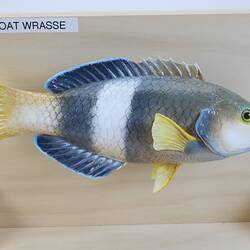General Description
Body moderately deep, dorsal fin low, long-based, head bluntly rounded in males. Greenish to reddish-brown, with pale centres on scales and a broad dusky band on sides (females), or brownish to bluish-grey with a white band on sides and another on tail base, a pale head, a blue chin and yellow pectoral, pelvic and caudal fins (males). Maximum total length 50 cm.
Biology
The most common and abundant wrasse on rocky reefs in Victoria and Tasmania. Bluethroat Wrasse begin life as females and change sex to males at a length of about 20-25 cm. The drably-coloured juveniles and females are common in seagrass and algal habitats, while the brightly-coloured males roam large territories.
Distribution
South-eastern Australia.
Habitat
Algal-covered rocky reefs in bays and coastal waters, to depth of 160 m.
More Information
-
Animal Type
-
Animal SubType
-
Brief Id
Greenish to reddish-brown with a broad dusky band on sides (females), or brownish to bluish-grey with a white band on sides, a bluish chin and bright yellow pectoral, pelvic and caudal fins (male).
-
Habitats
-
Diet
Benthic invertebrates
-
Endemicity
-
Commercial
Yes
-
Conservation Statuses
CITES: Not listed, FFG Threatened List: Not listed, EPBC Act 1999: Not listed, IUCN Red List: Least Concern
-
Depths
Shallow (1-30 m)
-
Water Column Locations
On or near seafloor
-
Taxon Name
-
Scientific Author
(Richardson, 1840)
-
Common Name
Bluethroat Wrasse
-
Kingdom
-
Phylum
-
Subphylum
-
Superclass
-
Class
-
Order
-
Family
-
Genus
-
Species Name
tetricus










